Adding driftwood, rocks, and plants to your fish tank is a great idea, but these may come with unexpected intruders that can eventually cause trouble.

The first time I witnessed a concerningly large number of small aquarium snails in my tank was at night.
It left me shocked, as I hadn’t seen any signs of infestation during the day. It turned out that it was common behavior for these tiny cone-shaped snails that I later identified as Malaysian Trumpet Snails.
Since they’re nocturnal, they’d hide under the substrate during the day, which is why I couldn’t really tell they were overpopulating my aquarium.
I then tried to get rid of them as fast as I could, but for a while, it was hard to keep their number under control.
In this guide, I’ll go over the most common smaller types of freshwater aquatic snails that infest fish tanks.
I’ll make it easier for you to identify these small gastropods and eradicate them, by giving you simple yet efficient tips from my experience.
So let’s dive in.
See Also: The 14 Popular Freshwater Snail Species for Your Aquarium for a list of pet snail recommendations.
What separates “Good” from “Bad” Snails in a Fish Tank?
Over the years, I’ve intentionally added Nerite, Mystery, Rabbit, and Assassin snails to some of my freshwater aquariums.
Technically, all freshwater snails are good to have in an aquarium.
Some of them sift the substrate and prevent toxic gasses from building up under it. Others eat food leftovers, dead plant matter, and even dead fish instead of letting them rot and spoil the fish tank’s water. After all, some of them keep algae under control, like a good Nerite snail would.
What separates good from bad snails in aquarium upkeep is the snails that do things we don’t want them to. These are things like feeding on healthy plants or breeding to the point you’ve got whole areas of the tank covered in snail shells. Some types of tiny snails are prolific breeders that can overrun an aquarium almost overnight. These are the type of snail we’d call a pest snail.
Larger snails like the Mystery snail are generally not considered a pest in aquariums because they can’t reproduce as quickly thanks to the unique way they lay their eggs, for example. I’d say that the larger ones are pretty much safe, as long as they don’t lay unsightly eggs that would never hatch.
The 4 most common tiny aquarium snails that can be a pest
Small snails and their babies usually appear in our fish tanks with our help.
In almost 100% of the cases, the new snails were “hitchhiking” on a piece of decor or an aquatic plant you introduced to the tank.
Some were still babies while doing so and others were still eggs.
So here are the small aquarium snails that can infest your fish tank:
1. Malaysian Trumpet Snail – Melanoides tuberculata

by cdeawa
Because of its fast reproduction rate, the Malaysian Trumpet snail is one of the most common small gastropods that infest freshwater aquariums. It is actually an invasive species introduced to the US by the aquarium hobby.
These tiny aquatic creatures hitchhike on aquatic plants and decorations and are often introduced to a home aquarium non-intentionally.
It’s quite easy to identify the Malaysian trumpet snail – it has a long conical shell with rings that resembles the shape of an ice cream cone.
The color of these little intruders varies from one specimen to another – they can be brown, gray, creme-colored, or even yellow.
Some Malaysian trumpet snails even have dark red or brown stripy patterns and speckles on their shells.
These cone-shaped freshwater snails remain tiny throughout their lifetime as they reach a maximum size of around 1.4 inches (3.6 centimeters).

When they’re juvenile, they’re extremely small and would often hide in the substrate and among the stems or leaves of plants.
That’s why you wouldn’t even notice how much they’ve grown in number until they reach a certain size and crawl out of their hiding spots at nighttime.
Malaysian Trumpet snails feed on algae, uneaten fish and shrimp food, and decaying plant matter.
In fact, these snails can bring some benefits to an aquarium:
- They burrow into the sand and are great at aerating it. This behavior prevents dangerous gas buildup in the substrate;
- They are efficient scavengers that keep unwanted algae growth and aquarium debris under control;
- They do all of the above without causing any harm to healthy aquatic plants.
Even though they’re beneficial to a certain degree, Malaysian trumpet snails are often considered pests.
They multiply rapidly and can overpopulate your aquarium in no time.
The high reproduction rate is caused by the fact that these snails are what’s known as parthenogenetic.
This means that the female Malaysian trumpet snails can reproduce without being in contact with a male.
Furthermore, these small aquarium snails are quite hardy and can live a healthy life in a wide range of water conditions. If there’s an abundance of food leftovers, algae, and rotten plants – these tiny gastropods will start multiplying like crazy.
You can control their reproduction rate by doing two things:
- reducing the amount of food you feed to your pet fish;
- minimizing the food surplus in the tank overall.
Nevertheless, once Malaysian trumpet snails have grown in number, it can be quite difficult to get rid of them.
This is another reason why many aquarists view these aquatic creatures as an extremely annoying pest.
Like other nuisance snails, Malaysian trumpet snails tend to clog filters, intake strainers, and impellers, which I’ve found to be quite frustrating.
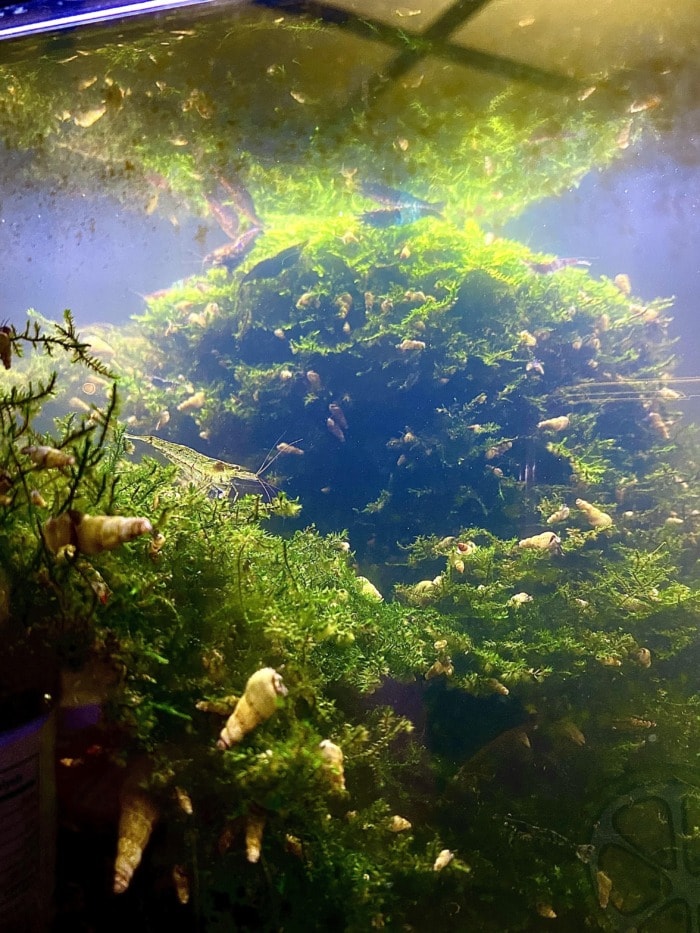
With that being said, many fellow hobbyists of mine keep Malaysian trumpet snails on purpose…
The people in question cite these snails’ great scavenging and sand-sifting abilities as the reason.
Anyway, I’ve found that I should feed my pet fish moderately, and there shouldn’t be unlimited food sources for these tiny creatures.
I’ve discovered that by following these two simple rules the Malaysian trumpet snails won’t cause an infestation and overpopulate my aquarium.
2. Ramshorn Snails – Planorbis Arnoldi
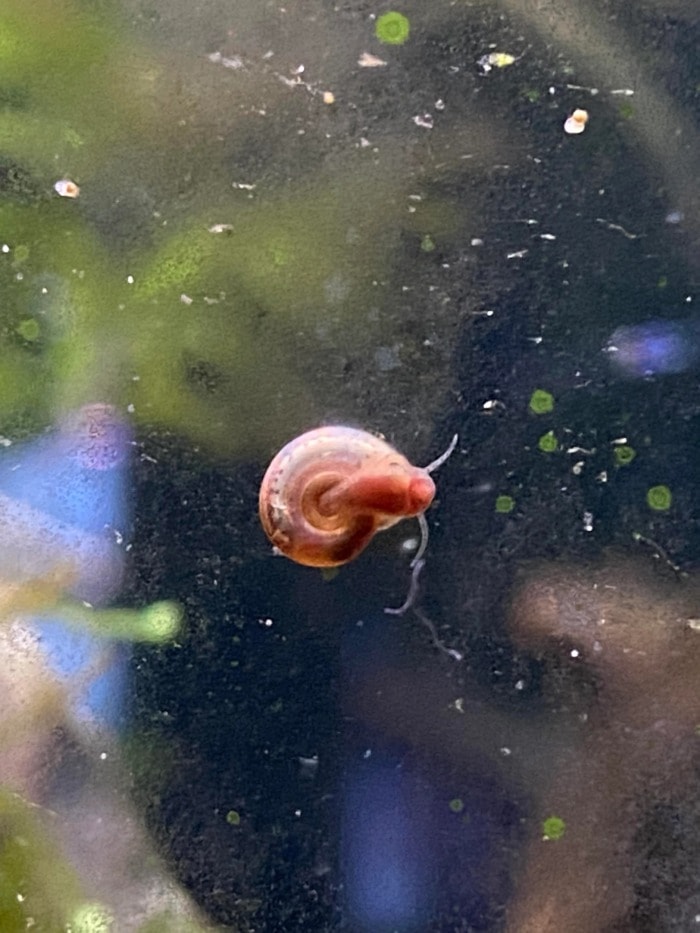
Mini Ramshorn snails are representatives of a very tiny snail species from the freshwater Planorbis genus. They have shells that can appear white or light pink and don’t grow much at all.
This species grows to a maximum size of a quarter of an inch (6 mm) making the Mini Ramshorn snails one of the smallest freshwater snails.
Because of their small size, these spiral-shaped white snails attach to plants and decorations unnoticed and travel to home aquariums by accident.
If there’s enough food, the Mini Ramshorn snails multiply rapidly and lay a dozen clear eggs at a time. Their eggs are quite hard to notice, especially if attached to plants or decorations.
Therefore the addition of a new plant or decorative piece often has aquarists surprised by the following micro snail outbreak.
These little aquatic creatures are considered pests in the aquarium hobby since they reproduce quite rapidly and may overpopulate the aquarium.
Especially if there are too many food sources available to them.
Anyway, Ramshorns are hermaphroditic, which means that two specimens of any sex can breed.
Once added to the aquarium, its whole glass may become covered in hundreds of these small white snails in no time.
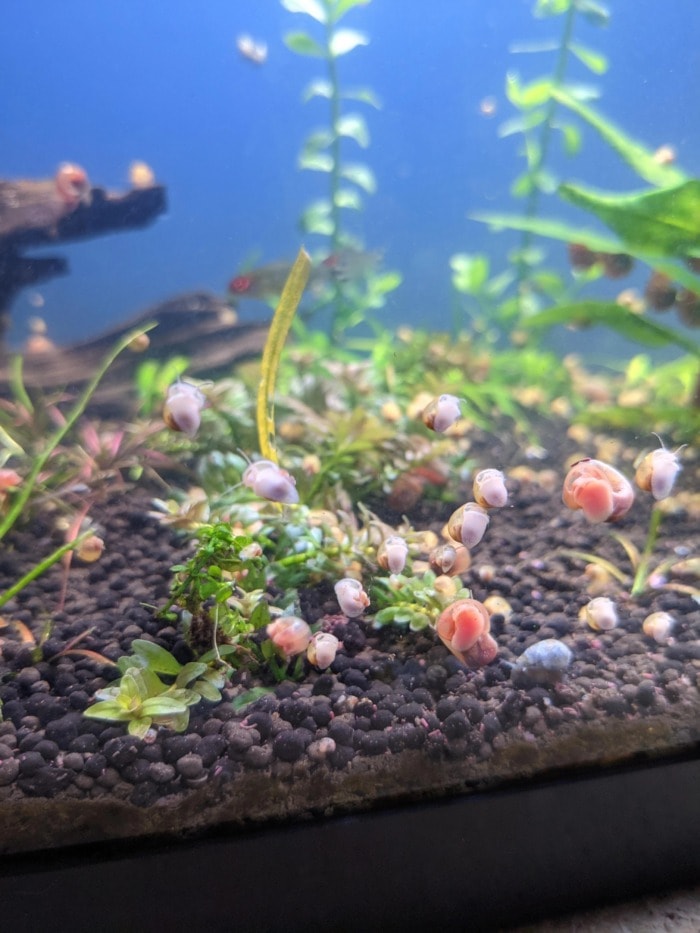
Even though they’re great at keeping the glass clean from algae, too many Mini Ramshorns would inevitably spoil the looks of your display tank.
Furthermore, these little gastropod mollusks tend to get into aquarium filters and in-between tiny crevices.
This habit of theirs makes it very hard to remove them in order to handle the infestation and completely eradicate them.
Mini Ramshorn snails are actually very common in the aquarium hobby.
They are great scavengers that take care of excessive algae growth.
Mini Ramshorns also feed on rotten plants and uneaten foods.
See Also: What Do Freshwater Aquarium Snails Eat? (+Tips) for more on what to feed your pet snails
Nevertheless, aquarists add a different Planorbarius species to their tank intentionally – the Great Ramshorn snail (Planorbarius corneus).
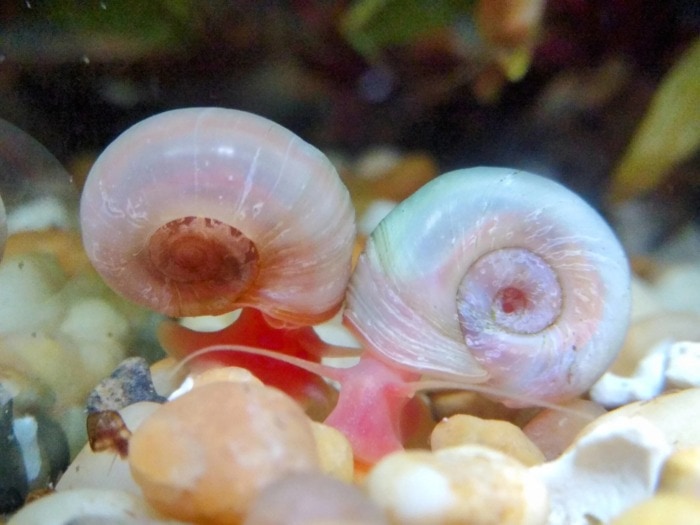
The Great Ramshorn snail is bigger in size – around 1.6 inches (4 cm) when fully grown.
The bigger Ramshorns have attractive looks and vary in coloration.
There are darker brown, orange, and pink ramshorns.
The Mini ramshorn is quite similar to the Great Ramshorn.
However, the shells of the former go out to the side and layover sideways, while the shell of the latter stays up on its back.
The bigger ramshorn species may also reproduce rapidly if there is an unlimited food source, but it takes more food for them to multiply at such a high pace.
Furthermore, Great Ramshorn snails are easier to locate and remove, unlike the Mini Ramshorns.
3. Bladder snails – Physella acuta

The bladder snail is one of the most common aquarium snails that infest freshwater fish tanks.
I’ve often accidentally introduced them to my systems with the addition of new plants.
They fulfill the four main traits of a resourceful aquarium pest:
- These small aquatic snails thrive in a variety of water conditions;
- Since they’re hermaphrodites, they are prolific breeders;
- The more food they have available – the more they multiply;
- Bladder snail eggs are clear and very hard to locate.
Bladder snails are omnivores but they mainly eat algae, so they are great cleaners.
They are quite small – 0.6 inches (1.5 cm) when fully grown. Bladder snails also tend to lay their eggs in the canister filter and their babies would stay in there for a while, which can clog the filter up.
These little creatures are often confused with another tiny aquarium snail that is considered a pest – the pond snail. Bladder snails have a brown or dark yellow semi-translucent shell that often has yellowish speckles.
The shell of the bladder snail is used to identify the species, as unlike other snails – it spirals to the left.
The bladder snails also have thinner antennas, compared to pond snails.
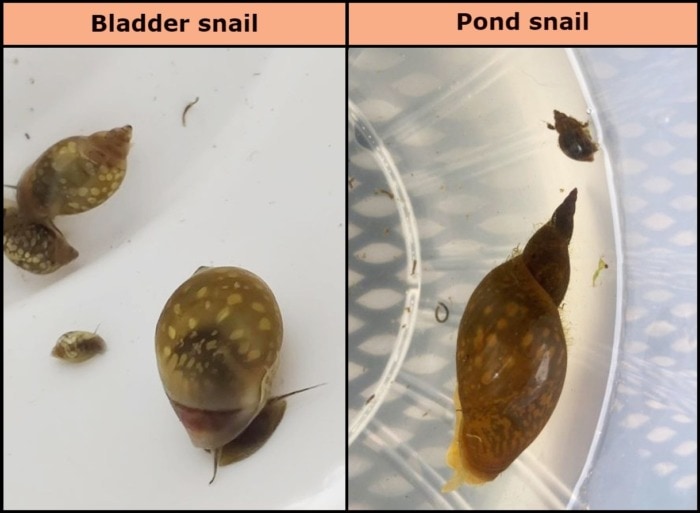
Both bladder and pond snails are considered aquarium pests, as they tend to spread rapidly if food is abundant.
Nevertheless, I’ve actually found it harder to get rid of bladder snails, as they are tinier and somewhat more successful when it comes to hiding.
4. Pond Snails – Lymnaea Stagnalis

Pond snails are small freshwater snails that usually reach a maximum size of 1 to 2.5 inches (2.5 cm to 6 cm).
These are the largest of the small snails on this list.
They are hermaphrodites that reproduce rapidly if there’s too much excess food leftovers, algae, and decaying plant matter.
Unwanted Pond snail outbreaks happen relatively often in the aquarium hobby.
For this reason, these tiny aquatic creatures are considered pests by many aquarists.
Pond snails are usually light or dark brown. You can also recognize them by their behavior – they are more active during the night.
These small snails can easily sneak into your tank with the addition of a new plant or decoration. That’s due to Pond snails laying batches of transparent jelly-like eggs that are hard to locate with the naked eye.
The pond snail babies mature quickly which contributes to a surprise infestation.
Anyway, these small aquatic inhabitants eat algae, excess fish food, and dying plants.
If you’re overfeeding your pet fish, the pond snails may explode in population and overrun your aquarium surprisingly fast.
How to get rid of small pest snails in your aquarium?
A pest snail outbreak in your aquarium indicates that something’s wrong with the system.
Pest snails reproduce fast when there is an unlimited food source readily available to them.
To prevent them from multiplying rapidly and overpopulating your tank, you should make sure that you don’t overfeed your fish.
No resources in an aquarium will ever go to waste. It will be either your fish and plants that will take advantage of the surplus or a pest such as snails, worms, or algae.
Anyhow, if there’s a snail outbreak in your tank, you should also have a look at your aquatic plants.
If they are dying off, then they are leaving too much decaying plant matter for the snails to eat.
This in itself may explain why the gastropods reproduce so rapidly.
Of course, too many snails in your tank may also indicate that you should put a bit more effort into its maintenance (vacuuming the substrate, water changes, etc.).
With that being said, I have a resource describing a few more ways to get rid of an infestation in your aquarium. Here’s a quick summary of that:
- Manually remove the small pest snails. You should do that daily to achieve satisfying results. The thing is that during the day it may be hard to locate all of the tiny snails, which is why it may be better to place bait in a snail trap at night.
- Place a piece of cucumber or zucchini in the tank at night as bait. Most aquatic snails are nocturnal and will bunch up on the piece of food during the night. The next morning you could easily remove the bait along with an impressive number of little snails on it. Do that consistently until they reduce in numbers.
- Place a bottle snail trap with bait. Cut the top part of a small 16 fl. oz. (0.5 l) bottle, remove the lid, invert the top piece and place it into the bottom part of the bottle. Add a piece of lettuce, cucumber, zucchini, or fish food inside the bottom part of the bottle and place the trap in the tank. Leave it there overnight. The following morning it will be full of tiny snail intruders that you could easily remove.
- Feed them to snail-eating fish. Many aquarists would add fish that eat snails, such as dwarf pufferfish or botias, to their tanks. Some would even add assassin snails that are pretty effective at reducing the number of nuisance snails. You can check out my article on freshwater snail-eating fish to get some cool stocking ideas. There you will also get basic care tips so that you know whether a given snail eater is compatible with your current aquarium stock and setting.
- Squish the snails if you have snail-eating fish that don’t seem interested. Many aquarists would actually squish the tiny snails one by one while they’re still in the tank. This should pique the interest of your snail-eating fish. Keep in mind that this should only be done if there are snail eaters inside the tank. If not – the dead snails will start decomposing and may cause an abrupt ammonia spike in your tank.
My final words
Small snails would only infest freshwater aquariums if there’s too much food available to them.
If you do proper fish tank maintenance, you won’t experience snail outbreaks, even if you’ve accidentally introduced some of the prolific species described above.
There are quite a few advantages to keeping aquatic snails anyway.
They will clean your display tank glass from algae, and take care of food leftovers and decaying plant matter.
They’d also aerate the substrate. Furthermore – they are a great tank health parameter.
If they start multiplying rapidly, you should definitely look into your aquarium’s condition.
Anyway, I hope that you found my article useful.
Feel free to leave me a comment below.

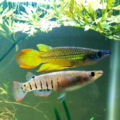
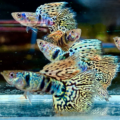

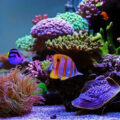



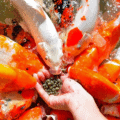


wow thank you so much, now i know what im doing…
it was helpful. thank you. A lot of information and tips.
I don’t want the little snails but feel bad squishing them. 🙂
I would make a bad farmer
Still learning each day. thanks again
Hi,
You can try exporting them by using some sort of DIY snail trap. Be mindful of where you release them, as not to disrupt your local ecosystem.